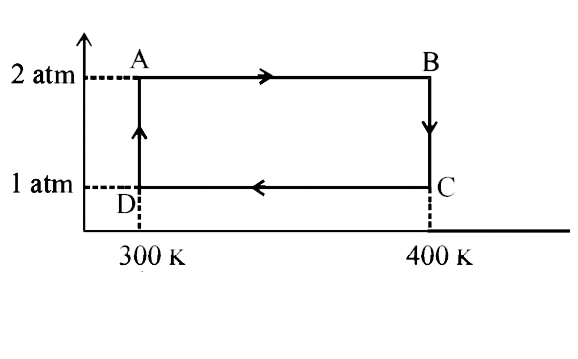Two moles of helium gas undergo a cyclic process as shown in Fig. Assuming the gas to be ideal, calculate the following quantities in this process

(a) The net change in the heat energy
(b) The net work done
(c) The net change in internal energy
The process from A to B is isobaric (at constant P)
∴WAB=PdV=nRdT=2R(400−300)=200R
The process from B to C is isothermal (at constant temperature)
∴WAB=∫VCVBpdV=∫PCPB−VdP
=∫PCPB−nRT(dPP)=nRTlogePCPB=nRTlogePBPC=2R×400loge2
The process from C to D is isobaric (at constant P)
∴WCD=nRΔT=2R(300−400)=−200R
The process from D to A is isothermal (at constantT)
∴WDA=−nRTlogPAPD=−2R×300loge2
Total work done in the whole cycle
W=WAB+WBC+WCD+WDA=200R+800Rloge2−200R−600Rloge2
W=200Rloge2=200×8.32×2.303×0.3010=1153.5J
(ii) As the system returns finally to its initial state, there is no change in internal energy, i.e., ΔU=0
(iii) From first law of thermodynamics, ΔQ=ΔU+ΔW=0+1153.5=1153.5J
Topper's Solved these Questions
- THERMODYNAMICSBook:PRADEEPChapter:THERMODYNAMICSExercise:Value based Questions
Explore 4 Videos
- THERMODYNAMICSBook:PRADEEPChapter:THERMODYNAMICSExercise:NCERT Questions
Explore 10 Videos
- THERMODYNAMICSBook:PRADEEPChapter:THERMODYNAMICSExercise:Long answer questions(NCERT)
Explore 5 Videos
- SYSTEMS OF PARTICLES AND ROTATIONAL MOTIONBook:PRADEEPChapter:SYSTEMS OF PARTICLES AND ROTATIONAL MOTIONExercise:Assertion- Reason Type questions
Explore 20 Videos
- WORK, ENERGY AND POWERBook:PRADEEPChapter:WORK, ENERGY AND POWERExercise:Assertion-Reason Type Questions
Explore 24 Videos
Similar Questions
One mole of Helium gas undergoes a reversible cyclic process ABCDA as shown in the figure.Assuming gas to be ideal, answer the following questions :

What is the net work involved in the process A to C :
View SolutionOne mole of Helium gas undergoes a reversible cyclic process ABCDA as shown in the figure.Assuming gas to be ideal, answer the following questions :

What is the value of 'q' for the overall cyclic process:
View Solution
Knowledge Check
Two moles of helium gas undergo a cyclic process as shown in figure. Assuming the gas to be ideal. The net work done by the gas is
 A200 Rln2B100 Rln2C300 Rln2D400 Rln2
A200 Rln2B100 Rln2C300 Rln2D400 Rln2Two moles of helium gas undergo a cyclic process as shown in figure. Assuming gas to be ideal, the net heat exchange in the process will be
 A1000 JB1152 JC1200 JD1500 J
A1000 JB1152 JC1200 JD1500 JTwo moles of Helium gas undergo a reversible cyclic process as shown in figure. Assuming gas to be ideal, what is the net work involved in the cyclic process ?
 A−100Rln4B+100Rln4C+200Rln4D−200Rln4
A−100Rln4B+100Rln4C+200Rln4D−200Rln4
One mole of Helium gas undergoes a reversible cyclic process ABCDA as shown in the figure.Assuming gas to be ideal, answer the following questions :

What is the value of ΔH for the overall cyclic process:
View SolutionTwo moles of an ideal monoatomic gas undergoes a cyclic process ABCA as shown in V-T diagram below:

Heat supplied to the gas during the process AB is :
View SolutionTwo moles of helium gas are taken over the cycle ABCDA , as shown in the P-Tdigram

Assuming the gas to be ideal the work done on the gas in taking if from A to B is -
View SolutionIn a cyclic process, the internal energy of the gas
View SolutionIn a cyclic process, the internal energy of the gas
View Solution

